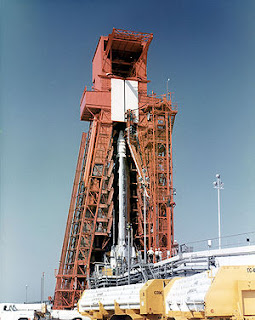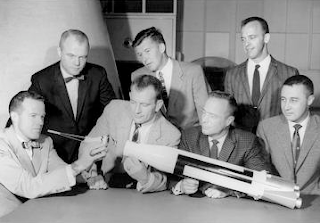
President Kennedy with Air Force Generals at Vandenberg AFB. Picture from the SAC Elite Guard Association site.
On March 23, 1962 President John F. Kennedy did something no other president had ever done. He watched a test firing of an Atlas D InterContinental Ballistic MIssile (ICBM) from a silo at the Vandenberg Air Force Base in California. Vandenberg AFB was the site for many of the military test missions of ICBM's, and also included launch silos for operational use of in-service ICBMs.

Welcome for Air Force One and the President. Picture from the SAC Elite Guard Association site.
It's important for us to remember today, that way back then in the early 60's our nation was experiencing the Cold War with our enemies, Soviet Russia. ICBMs stood by in each country ready to launch and inflict nuclear warfare on the other nation. So it seems more than appropriate that the American President should have been witness to a launch of our country's most important defensive weapon at the time. At the same time, both of our countries were engaged in a politically-inspired race of technology to conquer space and lead the world in space technology. In 1962, the Soviets seemed to be winning that race, and President Kennedy was gearing up the nation to be the first to land men on the Moon.

Atlas D ICBM at Pad 12 at Cape Canaveral.
The rocket launched that day from California was the Atlas D model ICBM. This type first flew in 1959. The operational rocket witness by the President was launched from a silo buried in the ground to protect it from enemy attack and hide it from surveillance. I was unable to find a picture of the silo and launch, though there is a video on Youtube that shows President Kennedy observing the blast-off: http://www.youtube.com/watch?v=3j5UaRnk4mg
(Thanks HelmerReenberg and Youtube!) I've included a picture of an Atlas D model at Launch Complex 12 at the Cape Canaveral Air Force Station in Florida. The Atlas D was used for other NASA purposes as well, including 4 Mercury Program launches.









